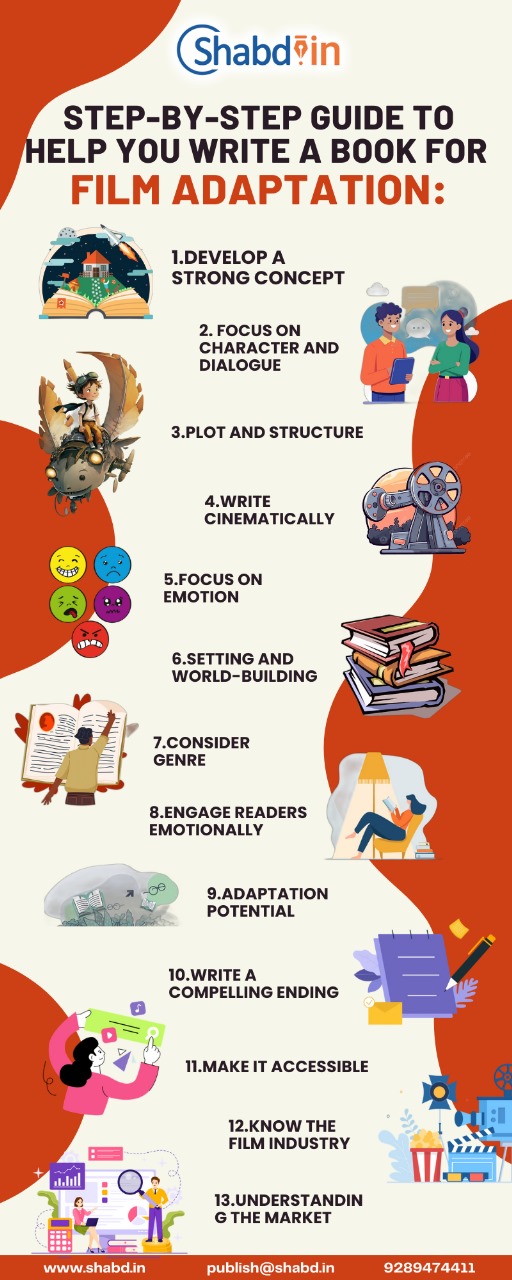Writing a book with the goal of film adaptation requires a careful balance between crafting a compelling written narrative and envisioning how it might translate visually. Here’s a detailed description for each step in the process:
1. Develop a Strong Concept
Start with a unique and gripping idea that can captivate both readers and filmmakers. Your concept should be something that stands out, easily summarized in a sentence or two, and has clear potential for visual storytelling.
2. Focus on Character and Dialogue
Well-developed characters and sharp dialogue are essential for both novels and films. Create dynamic, relatable characters whose motivations drive the story. Dialogue should be authentic and engaging, as this will help your book transition smoothly into a screenplay.
3. Plot and Structure
Films often follow a three-act structure, and your book can benefit from this too. Build your story with clear plot points, rising action, and climactic moments that will translate well onto the screen. Ensure each scene drives the story forward and has a purpose, leaving room for visual representation.
4. Write Cinematically
Visualize your scenes as you write them. Describe actions, settings, and emotions in a way that can easily be imagined by readers—and later, by filmmakers. Avoid excessive exposition and focus on showing rather than telling to keep your prose visually engaging.
5. Focus on Emotion
Movies thrive on emotional resonance, so ensure your story has moments that evoke deep feelings. Whether it’s joy, sorrow, suspense, or excitement, make sure the emotional journey of your characters is clearly conveyed, as this is what will draw in both readers and film audiences.
6. Setting and World-Building
Create vivid, detailed worlds that filmmakers can envision translating to the screen. Whether your setting is realistic or fantastical, the environment should feel immersive and crucial to the plot. Paint a picture with your words that helps establish mood, tone, and atmosphere.
7. Consider Genre
Some genres lend themselves more easily to film adaptation, such as thrillers, action, romance, or science fiction. Understand the conventions of your genre and think about how it typically plays out in films. Consider what will make your book stand out within that genre for adaptation.
8. Adaptation Potential
As you write, keep in mind what elements might be tricky or expensive to film. Consider the scope of your story—whether it’s manageable for a film or would require significant alterations. Make choices that will appeal to producers by balancing creativity with practical concerns.
9. Engage Readers Emotionally
Books adapted into films often succeed because they leave a strong emotional impact on readers. Make sure your narrative evokes empathy, passion, or curiosity. The emotional depth in your book will translate into powerful moments on screen.
10. Write a Compelling Ending
Endings are crucial in both novels and films. Craft a resolution that’s satisfying, thought-provoking, and ties together the story’s themes. A strong ending not only leaves a lasting impression on readers but also makes your book a more attractive candidate for adaptation.
11. Make it Accessible
A successful film adaptation often requires streamlining complex plots and making the story accessible to a broad audience. Avoid overly convoluted subplots or intricate details that might confuse viewers. A clear, well-paced narrative is more likely to be adapted.
12. Know the Film Industry
Understand the current trends in film and television. Research what types of stories are being adapted and the studios, directors, or producers making those choices. Knowing the industry will help you write with a keen sense of what filmmakers are looking for.
13. Understand the Market
The book-to-film market is competitive, and not all books are suited for adaptation. Be aware of the marketplace, both in publishing and film, to ensure that your story aligns with current demand. Study successful adaptations to understand what made them appealing for the screen.
By following these steps, you can write a novel that not only captivates readers but also catches the eye of filmmakers. Strike a balance between literary quality and cinematic potential, making your story adaptable without sacrificing its heart.

